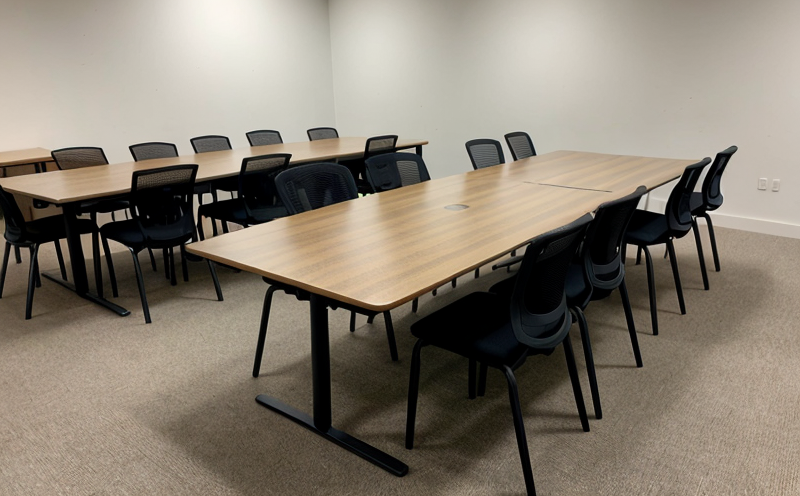DIN EN 581 Outdoor Furniture Tables Safety Mechanical and Stability Testing
The DIN EN 581 series of standards is specifically designed to ensure that outdoor furniture is safe, durable, and stable for use in various environmental conditions. This standard is particularly important for tables and desks used in public spaces such as parks, gardens, and recreational areas where they are subjected to weathering, traffic, and varying loads.
The mechanical stability testing within this framework focuses on the structural integrity of outdoor furniture under static and dynamic loading conditions. The aim is to determine whether the furniture can withstand anticipated stresses without failure or significant deformation. This includes tests for wind resistance, load distribution, and material fatigue under prolonged use.
For tables specifically, this involves evaluating the legs and support structures to ensure they remain stable even when subjected to heavy loads or sudden impacts. The stability test ensures that the table does not wobble or collapse under standard usage conditions. Additionally, durability tests assess how well the components will hold up over time against elements like UV radiation, rain, and extreme temperatures.
The mechanical testing also covers aspects such as the strength of joints between different parts of the furniture. This includes both manual assembly joints and those that might be fastened with screws or bolts. The standard specifies minimum values for these joint strengths to guarantee long-lasting performance in outdoor settings.
A critical aspect of this service is ensuring that all materials used meet specified environmental standards, which are crucial for maintaining aesthetic appeal while also enhancing durability. Compliance with international standards like DIN EN 581 helps manufacturers demonstrate their commitment to quality and safety, thereby gaining consumer trust.
| Test Type | Description |
|---|---|
| Mechanical Stability Test | Determines the furniture's ability to remain stable under specified loads and environmental conditions. |
| Load Distribution Test | Evaluates how evenly a load is distributed across multiple legs or supports. |
| Wind Resistance Test | Assesses the furniture’s capability to resist strong winds without toppling over. |
| Material Fatigue Test | Tests the resilience of materials used in outdoor furniture against repeated cycles of loading and unloading. |
Our service ensures that these tests are conducted rigorously, adhering strictly to the guidelines set forth by DIN EN 581. By doing so, we provide assurance not only regarding the safety but also the longevity of outdoor furniture products.
Applied Standards
The primary standard applied in our testing is DIN EN 581-3:2017-06 Outdoor Furniture - Part 3: Safety and stability requirements. This part of the series focuses explicitly on the safety aspects related to mechanical tests. It provides detailed instructions on how to perform various types of mechanical tests, including those aimed at assessing stability, load distribution, wind resistance, and material fatigue.
Other relevant standards include DIN EN 13400:2018 Outdoor furniture - General requirements, which sets out the overall criteria for outdoor furniture design; and DIN ISO 7205:2006 Stability of furniture under load. These complementary standards work together to create a comprehensive set of guidelines that cover all necessary aspects of designing, manufacturing, and testing outdoor furniture.
By adhering strictly to these international standards, we ensure that our clients receive accurate results and comply with regulatory requirements. This approach not only enhances the reputation of their brands but also protects users by ensuring products meet stringent safety standards.
Industry Applications
- Parks and Gardens
- Retail Spaces
- Restaurants and Cafes
- Community Halls
The DIN EN 581-3:2017 standard is widely applicable across multiple sectors, particularly those involving public spaces where furniture is exposed to the elements. In parks and gardens, for instance, tables need to be robust enough to accommodate picnickers and casual visitors while withstanding harsh weather conditions. Retail spaces benefit from durable, stable furniture that enhances customer comfort and satisfaction.
In restaurants and cafes, outdoor seating needs to be both functional and attractive, capable of supporting diners without compromising on aesthetics or durability. Community halls often require sturdy tables that can serve multiple purposes throughout the day, from meetings to social gatherings. All these applications emphasize the importance of mechanical stability and safety in outdoor furniture design.
| Application | Description |
|---|---|
| Parks and Gardens | Supports picnickers and casual visitors while withstanding harsh weather conditions. |
| Retail Spaces | Balances functionality, attractiveness, and durability for enhanced customer comfort. |
| Restaurants and Cafes | Serves as functional, attractive seating that supports diners without compromising on aesthetics or durability. |
| Community Halls | Provides sturdy tables suitable for various uses throughout the day. |
The mechanical stability and safety requirements outlined in DIN EN 581-3 are essential to ensure that outdoor furniture meets these diverse needs effectively. Compliance with this standard guarantees high-quality, reliable products that contribute positively to user experiences across different environments.
Use Cases and Application Examples
- Park Bench Testing: Ensuring benches can support multiple users without wobbling or collapsing.
- Garden Table Stability: Verifying that tables remain stable under various load distributions, including heavy rain.
- Cafeteria Table Durability: Assessing the resilience of cafeteria tables against daily use and harsh weather conditions.
- Hospital Outdoor Furniture: Guaranteeing that tables used in outdoor areas are safe for patients to sit on comfortably.
In each case, our testing process involves subjecting the furniture to real-world scenarios that simulate typical usage patterns. For example, when testing park benches, we apply simulated loads equivalent to multiple users sitting simultaneously and then observe if any structural issues arise. Similarly, for garden tables, we assess their ability to withstand heavy rain by simulating rainfall conditions in our climate chambers.
The results of these tests are meticulously documented, providing valuable insights into the performance characteristics of each piece of furniture tested. These data points help manufacturers make informed decisions about material selection and design improvements, ultimately leading to better-performing products.





